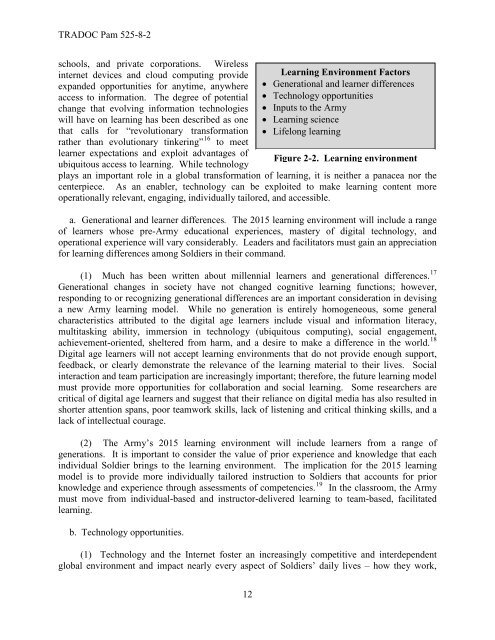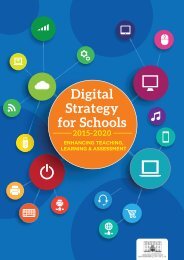K3zgZ
K3zgZ
K3zgZ
You also want an ePaper? Increase the reach of your titles
YUMPU automatically turns print PDFs into web optimized ePapers that Google loves.
TRADOC Pam 525-8-2<br />
schools, and private corporations. Wireless<br />
internet devices and cloud computing provide Learning Environment Factors<br />
expanded opportunities for anytime, anywhere • Generational and learner differences<br />
access to information. The degree of potential • Technology opportunities<br />
change that evolving information technologies • Inputs to the Army<br />
will have on learning has been described as one • Learning science<br />
that calls for “revolutionary transformation • Lifelong learning<br />
rather than evolutionary tinkering” 16 to meet<br />
learner expectations and exploit advantages of<br />
Figure 2-2. Learning environment<br />
ubiquitous access to learning. While technology<br />
plays an important role in a global transformation of learning, it is neither a panacea nor the<br />
centerpiece. As an enabler, technology can be exploited to make learning content more<br />
operationally relevant, engaging, individually tailored, and accessible.<br />
a. Generational and learner differences. The 2015 learning environment will include a range<br />
of learners whose pre-Army educational experiences, mastery of digital technology, and<br />
operational experience will vary considerably. Leaders and facilitators must gain an appreciation<br />
for learning differences among Soldiers in their command.<br />
(1) Much has been written about millennial learners and generational differences. 17<br />
Generational changes in society have not changed cognitive learning functions; however,<br />
responding to or recognizing generational differences are an important consideration in devising<br />
a new Army learning model. While no generation is entirely homogeneous, some general<br />
characteristics attributed to the digital age learners include visual and information literacy,<br />
multitasking ability, immersion in technology (ubiquitous computing), social engagement,<br />
achievement-oriented, sheltered from harm, and a desire to make a difference in the world. 18<br />
Digital age learners will not accept learning environments that do not provide enough support,<br />
feedback, or clearly demonstrate the relevance of the learning material to their lives. Social<br />
interaction and team participation are increasingly important; therefore, the future learning model<br />
must provide more opportunities for collaboration and social learning. Some researchers are<br />
critical of digital age learners and suggest that their reliance on digital media has also resulted in<br />
shorter attention spans, poor teamwork skills, lack of listening and critical thinking skills, and a<br />
lack of intellectual courage.<br />
(2) The Army’s 2015 learning environment will include learners from a range of<br />
generations. It is important to consider the value of prior experience and knowledge that each<br />
individual Soldier brings to the learning environment. The implication for the 2015 learning<br />
model is to provide more individually tailored instruction to Soldiers that accounts for prior<br />
knowledge and experience through assessments of competencies. 19 In the classroom, the Army<br />
must move from individual-based and instructor-delivered learning to team-based, facilitated<br />
learning.<br />
b. Technology opportunities.<br />
(1) Technology and the Internet foster an increasingly competitive and interdependent<br />
global environment and impact nearly every aspect of Soldiers’ daily lives – how they work,<br />
12




